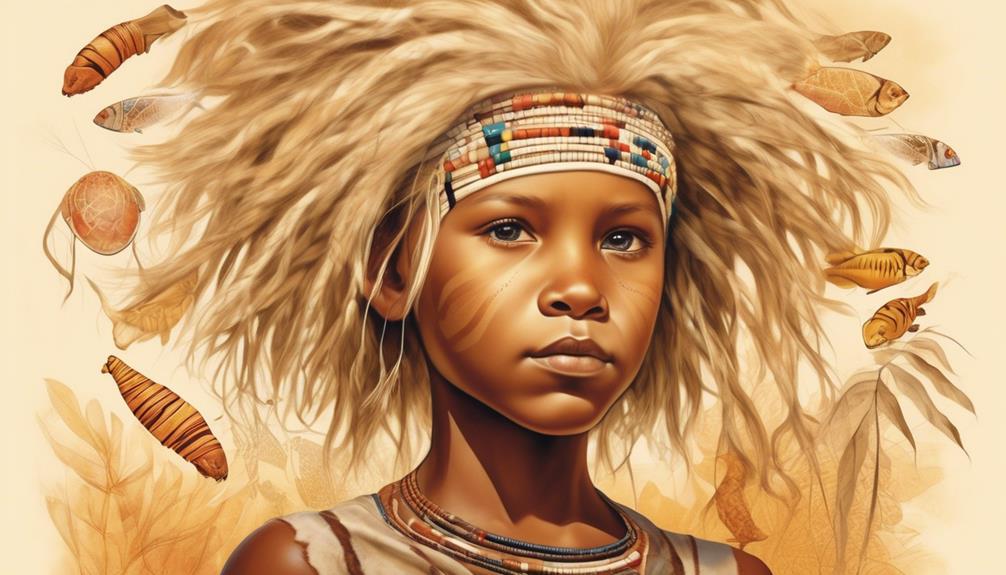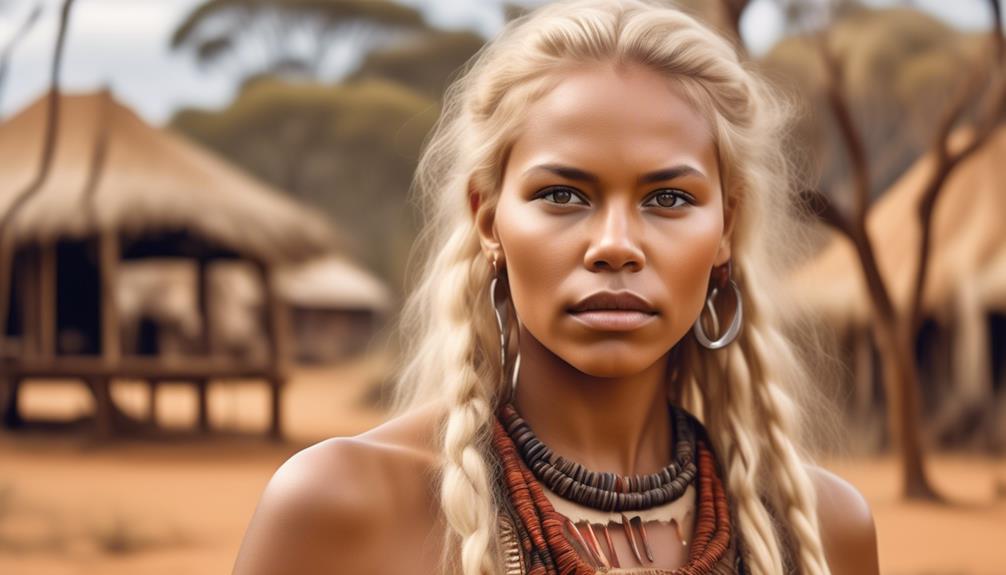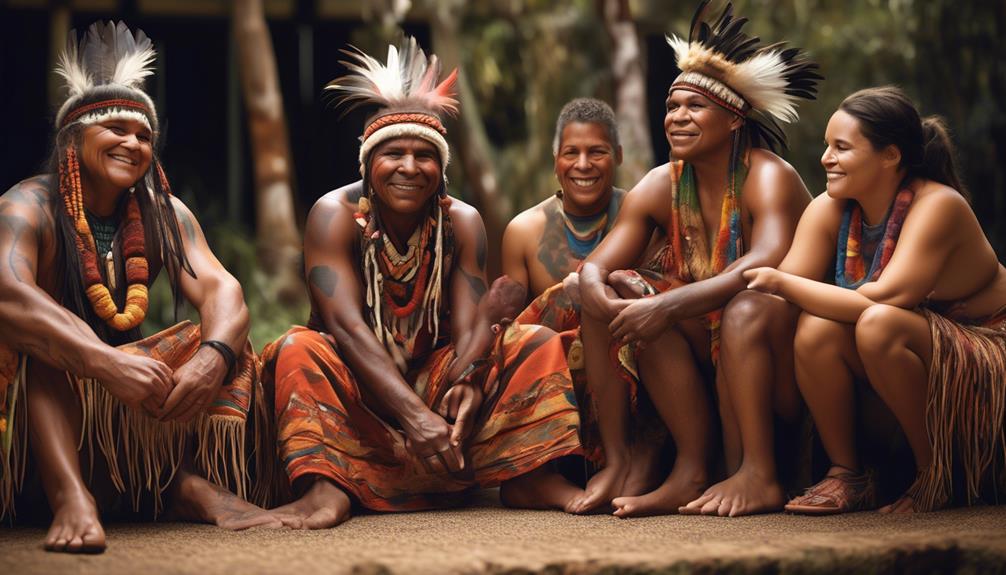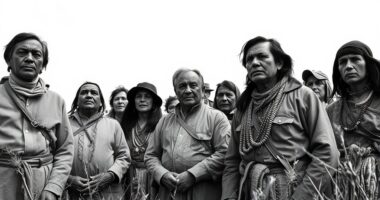Blonde hair among Aboriginal Australians has long sparked curiosity and investigation. Contrary to popular belief that blonde hair is uncommon among Aboriginal communities, the reality is more complex.
The origins and prevalence of blonde hair among Aboriginal Australians offer a rich tapestry of genetic, cultural, and historical nuances. From ancient accounts to modern scientific studies, the presence of blonde hair among Indigenous Australians has sparked curiosity and debate.
But just how common is it, and what factors contribute to its occurrence? Join us as we explore the intriguing world of blonde hair in Aboriginal Australians, delving into its historical significance, genetic underpinnings, and cultural interpretations.
Key Takeaways
- Historical accounts and genetic studies highlight the presence of blonde hair in Aboriginal Australians, challenging stereotypical perceptions.
- Genetic mutations, environmental factors, and evolutionary adaptations contribute to the diversity of hair colors, including blonde, among Aboriginal Australians.
- Blonde hair holds cultural significance in defining identity and ancestral connections, but acceptance and celebration of blonde hair vary among different Aboriginal communities.
- The frequency of blonde hair varies across different regions in Australia, potentially influenced by historical interactions and environmental conditions.
Historical Accounts of Blonde Hair in Aboriginal Australians
Historical accounts of blonde hair in Aboriginal Australians have been recorded by early European explorers and settlers, sparking curiosity and debate about its origins and significance within indigenous cultures. These historical accounts provide valuable insights into the genetic influences that contribute to the diversity of physical traits among Aboriginal Australians. The presence of blonde hair among some indigenous Australians challenges stereotypical perceptions and highlights the complexity of genetic inheritance within these populations.
Early European accounts describe encounters with Aboriginal individuals exhibiting varying shades of blonde hair, ranging from golden hues to lighter tones. These observations have led to discussions concerning the genetic influences responsible for this diversity in hair color. Genetic studies have revealed that variations in the MC1R gene, which regulates melanin production, can result in a range of hair colors, including blonde. This genetic diversity challenges simplistic notions of homogeneity within indigenous populations and underscores the rich complexity of their genetic heritage.
Understanding the historical accounts and genetic influences related to blonde hair in Aboriginal Australians contributes to a more comprehensive appreciation of the diversity and complexity of indigenous cultures. It also serves as a reminder of the importance of recognizing and respecting the uniqueness of each individual within these communities.
Genetic and Evolutionary Factors Contributing to Blonde Hair

The presence of varying shades of blonde hair among some indigenous Australians challenges stereotypical perceptions and prompts an exploration of the genetic and evolutionary factors that contribute to this diversity in hair color.
Genetic mutations play a crucial role in the expression of blonde hair in Aboriginal Australians. These mutations affect genes responsible for the production of melanin, the pigment that determines hair color.
Environmental factors also play a significant part in the manifestation of blonde hair. Exposure to sunlight can lead to the lightening of hair, particularly in individuals with genetic predispositions for lighter hair colors.
Evolutionary adaptations have also shaped the prevalence of blonde hair in Aboriginal Australians. Natural selection may have favored blonde hair in certain environments, providing a survival advantage, such as increased synthesis of vitamin D in regions with limited sunlight.
These factors collectively illustrate the intricate interplay between genetic mutations, environmental influences, and evolutionary adaptations in contributing to the presence of blonde hair among Aboriginal Australians.
Cultural Significance of Blonde Hair in Aboriginal Communities
Blonde hair in Aboriginal communities holds cultural significance that reflects the diversity and traditions within these indigenous groups. The symbolism of hair color plays a vital role in the cultural identity and social structure of Aboriginal communities. In many Aboriginal cultures, hair color is believed to be a manifestation of ancestral connections and spiritual significance. The acceptance and celebration of blonde hair vary among different Aboriginal groups, with some communities placing great value on its uniqueness, while others view it as a genetic trait with no particular cultural significance.
| Hair Color Symbolism | Cultural Acceptance |
|---|---|
| Represents ancestral connections and spiritual significance | Varies among different Aboriginal groups |
| Holds cultural significance in defining identity | Some communities celebrate its uniqueness |
The cultural acceptance of blonde hair in Aboriginal communities is a complex and nuanced aspect of indigenous traditions. While some view it as a symbol of diversity and heritage, others may not attribute significant cultural meaning to it. Understanding the diverse perspectives on blonde hair within Aboriginal communities is crucial for promoting cultural awareness and appreciation for the rich tapestry of indigenous traditions.
Variations in the Frequency of Blonde Hair Across Different Regions

Discussing the prevalence of varying hair colors in different Aboriginal regions provides a deeper understanding of the intricate cultural significance attached to these traits. When examining the frequency of blonde hair across different regions, it becomes apparent that regional differences and environmental influences play a significant role in shaping the diversity of hair colors within Aboriginal communities.
- Regional Differences
- In coastal regions, such as the Torres Strait Islands and parts of Northern Australia, a higher frequency of blonde hair is observed among Aboriginal individuals. This suggests a correlation between proximity to coastlines and the prevalence of blonde hair, potentially influenced by historical interactions with seafaring populations.
- In contrast, central desert regions exhibit a lower frequency of blonde hair among Aboriginal Australians. The harsh arid climate and environmental conditions in these areas may have contributed to the prevalence of darker hair colors as a protective adaptation against the intense sun exposure and dust.
- Environmental Influences
- The intensity of sunlight and UV radiation in different regions can impact the expression of genes responsible for hair color, leading to variations in the frequency of blonde hair.
Misconceptions and Stereotypes Surrounding Blonde Hair in Aboriginal Australians
Contrary to common misconceptions, the prevalence of blonde hair among Aboriginal Australians reflects a complex interplay of genetic, environmental, and historical factors. Blonde hair stereotypes have often perpetuated misunderstandings about its origins within Indigenous communities. These misconceptions can overshadow the diverse and rich cultural heritage of Aboriginal Australians.
Blonde hair in Aboriginal Australians has been misconstrued as a sign of diluted Indigenous representation or as evidence of non-Indigenous ancestry. Such stereotypes fail to acknowledge the historical and genetic complexities of Australia's Indigenous peoples. They also disregard the individual experiences and racial identity of Aboriginal Australians with blonde hair.
Understanding the misconceptions and stereotypes surrounding blonde hair in Aboriginal Australians is vital for promoting inclusivity and respect. It's essential to recognize that the diversity of physical traits, including blonde hair, doesn't diminish an individual's Indigenous heritage. By debunking these stereotypes and misconceptions, we can foster a more accurate and respectful representation of Aboriginal Australians and their rich cultural tapestry.
Frequently Asked Questions
How Does the Presence of Blonde Hair in Aboriginal Australians Challenge the Traditional Understanding of Indigenous Australian Appearance?
Challenging perceptions, genetic diversity in Aboriginal Australians is evident through the presence of blonde hair. This challenges traditional understandings of Indigenous Australian appearance, highlighting the diverse genetic heritage within Aboriginal communities.
The presence of blonde hair prompts a reevaluation of preconceived notions about Indigenous physical characteristics, emphasizing the need to recognize and celebrate the rich genetic diversity that exists within Aboriginal populations.
Are There Any Specific Rituals or Ceremonies Within Aboriginal Communities That Are Associated With Individuals Who Have Blonde Hair?
Ritual significance and cultural representation are deeply intertwined in Aboriginal communities. Blonde hair can hold unique significance in specific rituals and ceremonies, symbolizing connections to ancestral spirits or representing a particular role within the community.
The presence of blonde hair in these contexts can serve as a powerful reminder of the diversity and complexity of indigenous Australian traditions, challenging traditional understandings of appearance and identity.
What Are Some Common Misconceptions or Stereotypes About Blonde Hair in Aboriginal Australians and How Do They Impact the Community?
Misconceptions about blonde hair in Aboriginal Australians can have a significant impact on the community. These misconceptions often challenge traditional understandings of cultural diversity and can perpetuate harmful stereotypes.
Such stereotypes may lead to discrimination and exclusion, affecting individuals and the community as a whole. It's important to address and challenge these misconceptions to promote inclusivity and understanding within the community.
How Do Genetic and Environmental Factors Interact to Influence the Frequency of Blonde Hair in Different Regions of Australia?
Genetic variation plays a crucial role in the frequency of blonde hair in different regions of Australia. Environmental adaptation also contributes to the prevalence of this trait.
It's fascinating how these factors interact to shape the unique characteristics of Aboriginal Australians. The irony lies in the widespread misconception that blonde hair is uncommon among this community.
In reality, the interplay of genetics and environment showcases the diversity within Aboriginal populations.
Are There Any Historical Accounts or Stories Within Aboriginal Culture That Specifically Mention Individuals With Blonde Hair and How Are They Depicted in These Stories?
Blonde hair depiction in Aboriginal stories is a complex topic. Genetic and environmental factors play a role in Indigenous appearance, challenging stereotypical notions. Historical accounts and oral traditions may mention individuals with blonde hair, depicting them in various ways.
Understanding these stories requires sensitivity to cultural nuances and a willingness to engage with diverse perspectives. Recognizing the diversity within Aboriginal communities is essential when exploring the representation of blonde hair in their narratives.
Conclusion
In conclusion, the presence of blonde hair in Aboriginal Australians is a complex and multifaceted topic that warrants further exploration.
While some may question the significance of discussing the frequency of blonde hair, it's important to understand the genetic, cultural, and historical factors that contribute to the diversity within Aboriginal communities.
By gaining a deeper understanding of this topic, we can appreciate the richness and complexity of Aboriginal cultures and challenge misconceptions surrounding blonde hair in these communities.









